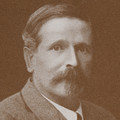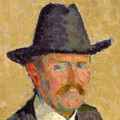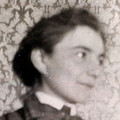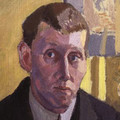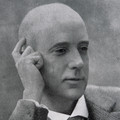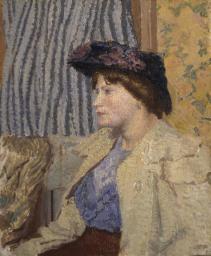Louis F. Fergusson, ‘Souvenir of Camden Town: A Commemorative Exhibition’
The Studio, February 1930, pp.111–9.
souvenir of camden town
a commemorative exhibition
By LOUIS FERGUSSON
AN exhibition with this title has opened this month at the Leicester Galleries. It deals with the Camden Town Group – a pre-war movement which included many of the most important figures in present-day British Art.
The prologue to the story of the Camden Town Group was played on a first-floor back-and-front in the purlieus of the Tottenham Court Road. For several years before the birthday of the Group Mr. Sickert – “ce Bonnard londonien” – and his fellow-workers kept open house at 19 Fitzroy Street on Saturdays. There was an appetising smell of tea and pigment as you ascended to a glorious afternoon of pictures and of talk. Easels and chairs faced the fireplace with a serried stack of canvases against the wall. Six works or more of an individual painter were extricated in turn, each Fitzroyalist displaying his quota or having it displayed for him by the untiring Gore.
Brief impressions of exhibitors and exhibits may serve to introduce some typical figures of the circle.
Mr. Sickert put every caller at his ease. “It is so nice,” he said, for example, to an appreciative but diffident visitor “to come across a person with the same religion as oneself – a good Impressionist!” Sickert was the host-in-chief; some [end of p.111] drawings and engravings of music-halls or café-concerts hung upon the walls together with a nude woman sprawling upon a divan – a marvellous fantasia in line, like an old Persian arabesque. Sickert’s work is now so famous that little description is needed of what rested upon chair and easel when he may be said to have come up with his “little lot.” But among abiding though probably inaccurate memories are a coster-girl in a sailor-hat – a tragic old woman with red-rimmed eyes, mamma mia poareta, huddled near a chest of drawers with a slender candlestick – Zangwill reading the “Westminster Gazette” and silhouetted against a Venetian piazza – Mr. George Moore visibly wilting.
Next might come the turn of Gore himself. He had the look of a dreamer, and the whimsical charm of his manner seemed to suggest that his art was making him supremely happy. His share in the afternoon’s diversion would be a gay and naïve cricket match – a dancer taking her call at a much-idealised Alhambra before a curtain that suggested Tiepolo – some landscapes from Somerset or Hertfordshire radiant in pure colour – and maybe a fat serio at the “Mo” putting her ditty over with some of the verve of Ada Lundberg as recorded by Sickert himself.
To Gore might succeed Gilman – a figure of dignity in snuff-coloured suit and black neckerchief. He impressed you with his transparent earnestness. Painting meant ever so much to him. He told you with the utmost conviction that Freddie Gore was going to be a very great painter, that the next important art-movement would certainly emanate from the room in which we were standing.
The Gilmans on view were mostly smooth interiors with much subtlety in the relation of colours. Gilman was a kind of Vuillard of London. But gradually a heightened key of colour and a more turbulent surface began to disclose his reaction to the compelling power of Cézanne and Van Gogh. And he lived to paint the forceful likenesses of his landlady [end of p.112] Mrs. Mounter, of Maple Street, now shown at the Leicester Galleries, and the large and splendid Halifax Harbour painted as a Canadian War Memorial.
Then there was Bevan. If, as Mr. Moore has said, there was always something in those days of the cleric and the actor about Mr. Sickert, there was certainly something of the squire and the lover of horse-flesh about Bevan. Bevan discerned a very strong pattern in fields and trees and farmsteads and expressed it in impasto with a great intensity of colour. But one thinks particularly of his horse-marts, [end of p.113] cab-yards, and assemblies of old crocks. In arbitrary and purely decorative colour he immortalised the world of Tattersall and Aldridge, of Shrewsbury and Talbot. He endowed the simplified figures of his Cockney stable-hands and horsey loafers with the right English raciness of Hogarth or Rowlandson. The London Museum should secure a few of these Bevans as a highly personal record of a phase of London life that has all but vanished.
A late adherent to the côterie, hailing from the Midi and Paris and hardly at home at first with his native syllables, was Mr. Ginner. He brought with him exciting tidings of the French rebels who were going to be known as Post-Impressionists. From his earliest London days with the Allied Artists Ginner combined a metallic glamour of colour with an extreme nicety of architectural drawing. His artistic mind was too well-balanced to have much – if any – truck with cubes, but for bricks he has almost an obsession. An influential critic at the first exhibition of the Camden Town Group singled out Ginner as the most daring of the contributors, and found in his still life “the passionate intensity of a Cézanne, but with a far better grip of form.” Leaving Sickert aside as hors concours, no living member of the Group seems more firmly established as a painter who counts than Ginner.
From 19 Fitzroy Street one’s thoughts often wandered to the Café de la Nouvelle-Athènes – surely with the Mermaid one of those legendary haunts that imagination most eagerly frequents. Not only because the names of Gilman and Ginner had nearly as much alliteration as Manet and Monet; not only because Sickert was intimate with the redoubtable Degas, and stood for [end of p.114] [beginning of p.116] solidarity with the whole tradition of the great Impressionists; but chiefly because a direct link with Impressionism was supplied by Mr. Lucien Pissaro [sic]. Mr. Pissaro was an honoured member of the circle and of the eventual group. He is a painter who invests railway bridges and cuttings, country fields and lanes, with magic effulgence. He has brought into the art of English landscape much of the all-embracing sunshine of his father and of Sisley.
The Camden Town Group held three exhibitions at the Carfax Gallery in Saint James’s in June and December of 1911 and in December of 1912. There were sixteen members – Walter Bayes, the late Robert Bevan, Malcolm Drummond, the late Harold Gilman, Charles Ginner, the late Spencer F. Gore, the late J. D. Innes, Augustus John, Henry Lamb, Wyndham Lewis, the late M. G. Lightfoot, J. B. Manson, Lucien Pissarro, W. Ratcliffe, Walter Sickert, and J. Doman Turner. Lightfoot dropped out after the first exhibition and was replaced by Mr. Duncan Grant. Mr. John, an old associate of the doyens Sickert and Pissarro, contributed two landscapes on the first occasion, but did not send again.
The Camden Town Group was mainly so called, perhaps, because Gore, its well-loved President, inhabited the township. But local colour was not lacking in the inaugural catalogue. Gore himself showed a vision of Mornington Crescent and a bed-sitting room clearly of those latitudes. Sickert showed two numbers of what he termed the Camden Town Murder Series: as good an occasion as another, no doubt, for uniting the draughtsman’s joy in the contrast of a clad and unclad figure with the painter’s joy in the variegated play of low-toned colours in a penumbra, and at the same time startling the cits. Doman Turner, again, introduced in pastel Duncan and Godfrey, a jolly duo from the great [end of p.116] [beginning of p.118] days of the Halls, and popular at the Bedford, that “Pav.” of Camden Town.
The notorious exhibition of Manet and the Post-Impressionists in the winter of 1910 had shaken artistic London out of its lethargy and exasperated, I regret to remember, not the baser critics only. The heresy-hunters were ready enough to classify the Camden Wonders (as Robert Ross called them) with the Post-Impressionists. But there was little at Carfax to disturb them except the geometrical faces of Mr. Wyndham Lewis’ architects and the slantwise gait of his hulking fishermen in the powerful canvas called Port de Mer.
Messrs. Sickert, John and Lamb were taken under the wing of the Contemporary Art Society as early as 1913, and by 1917 these painters together with Messrs. Grant and Pissarro had penetrated the Tate Gallery. The triumph of the Camden Town Group (1911–12) is that in this year of grace no less than twelve of its sixteen members have reached the National Gallery in Millbank either by gift or purchase. Beside the members just mentioned you will find there Walter Bayes, Innes, Lightfoot, Gore, Gilman and Ginner. While in the case of Mr. Manson, not only his joyous jarful of Michaelmas Daisies, but he himself is in the Tate. In 1911–12 the idea of translation to Millbank might have struck some of the Camden Town painters as anticlimax rather than a consecration. But the Tate to-day surely is one of the richest temples of modern art in the world thanks to its new wing, its less hampered directorate, and its enlightened donors.
Especially in a corner of Room XXV are you conscious of the spirit of the
Group. Arresting you with their brilliant reds and greens, Gore’s Houghton Place and Gilman’s Leeds Market hang one above the other – a souvenir of Camden Town in little. And it will be possible to stand at gaze there long after the Leicester Galleries’ happy thought in 1930 has ceased to be anything but a memory.
Group. Arresting you with their brilliant reds and greens, Gore’s Houghton Place and Gilman’s Leeds Market hang one above the other – a souvenir of Camden Town in little. And it will be possible to stand at gaze there long after the Leicester Galleries’ happy thought in 1930 has ceased to be anything but a memory.
***
Note
The illustrations in Louis F. Fergusson’s article are as follows (captions are provided in the original style):
“Inez and Taki.” A turn at the Alhambra in 1910. By Spencer Gore By courtesy of Louis F. Fergusson, Esq. [p.111. Tate N05859]
A fine example of M. G. Lightfoot’s grave and impressive design. (Leicester Galleries) [p.112]
Gauguins and Connoisseurs at the Stafford Gallery, 1911. By Spencer Gore. (Leicester Galleries) [p.113]
Sale at Tattersalls, by Robert Bevan. (Leicester Galleries) [p.114]
St. Jacques, Dieppe. By Walter Sickert. (Leicester Galleries) [p.115]
The Aqueduct, by Charles Ginner. By courtesy of Louis Fergusson, Esq. [p.116]
Boy’s Head, by Henry Lamb. By courtesy of Louis Fergusson, Esq. [p.117]
A characteristic example of J. D. Innes’ passion for Welsh mountains. (Leicester Galleries) [p.118]
“Mrs. Mounter.” By Harold Gilman (Leicester Galleries) [p.119]
How to cite
Louis F. Fergusson, ‘Souvenir of Camden Town: A Commemorative Exhibition’, in The Studio, February 1930, pp.111–9, in Helena Bonett, Ysanne Holt, Jennifer Mundy (eds.), The Camden Town Group in Context, Tate Research Publication, May 2012, https://www

